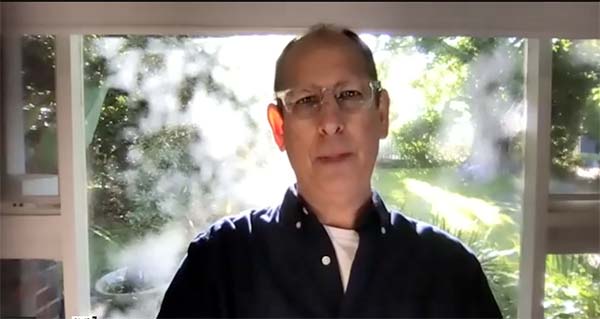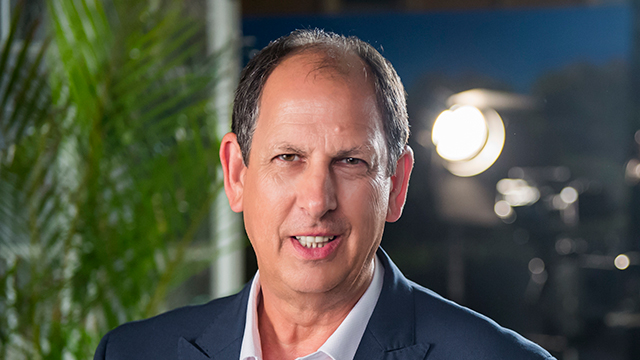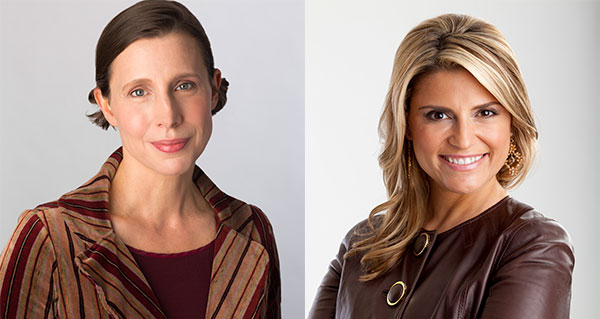Jonathan Shiff, Angela Santomero, Tom McGillis and Ben Bocquelet weighed in on the keys to creating successful shows for kids at a session at MIPJunior today moderated by World Screen’s Anna Carugati before each receiving a Kids Trendsetter Award.
The fourth annual World Screen Kids Trendsetter Awards were presented to these leading creators in recognition of their contributions to the children’s programming business.
Santomero, the creator of Blue’s Clues and Daniel Tiger’s Neighborhood and chief creative officer at 9 Story Media Group, came to television after gaining a Master’s degree in child development and psychology and instructional technology and media. “I studied for this job,” she said. “I really wanted to take what was wonderful about children’s education and curriculum, because I wasn’t a fan of much of what was on TV at the time, and put that point of view into storytelling.”
Bocquelet, the creator of the Cartoon Network hit The Amazing World of Gumball, said his background was more “run of the mill,” having gone to animation school and working his way up to a showrunner and director. “I just had to wing it!”
Shiff is behind the tween live-action hits H2O—Just Add Water and Mako Mermaids, among others. “I was actually running away from something!” Shiff quipped about how he entered the content business. The former property lawyer decided, after his daughter was born 30 years ago, that there wasn’t much for her to watch, leading him into a post as a legal advisor on a prime-time show “on the basis that they would train me as a producer.”
McGillis founded Fresh TV with Jennifer Pertsch after working at Nelvana, and together the duo created the hit Total Drama Island franchise, among several other series.
Carugati asked the panelists about the elusive sparks of creativity that birthed their shows.
For Santomero’s first series, Blue’s Clues, it was about answering the question of what a preschool game show would look like. “A lot of times I approach things as, Why this show, why now? For Blue’s Clues it was, could preschoolers be contestants? That started the idea. For Daniel Tiger’s Neighborhood, it was about bringing Fred Rogers’ legacy to the forefront. And then in Super Why! we wanted to marry reading with superheroes, the power that you have when you learn to read.”
For Bocquelet, the creative spark mostly comes from “everyday experiences. I have a weirdly dysfunctional but very happy family. I have had a whole bunch of weird stuff happen to me and keeps happening to me! I’m basically making money off their pain and misery!”
“It’s not an easy process,” said Shiff. Ideas can come from looking at gaps in the market, but ultimately “stories come within, an emotional connectivity to the story, a passion for the story. In the case of H2O, I had done Ocean Girl, so I had a passion for underwater. I work very closely with Nicole Keeb at ZDF and often she’s whispering in my ear about something that might spark [an idea]. But generally, it comes from within. These are your babies for a couple of years, so you want that passion, you want to be connected to it.”
McGillis also pointed to the importance of “talking with broadcasters. Total Drama, for instance, came as a request from Teletoon. They said, We want an animated reality show. [Jennifer and I] collaborate a lot. The spark is always weird and different and surprising. She and I will bat things back and forth and either kill them or suddenly they come to life right in front of us. Definitely, the broadcaster aspect is crucial.”
The conversation then moved to the importance of comedy in kids’ TV. “It’s a bonding tool,” Santomero said. “We can all laugh together. That can bring more viewers in. For little ones, it’s more about surprises and silliness. As they get older it’s more about joint embarrassment or a situation that makes everybody laugh together, rather than laughing at [someone].”
Bocquelet said that slapstick is key for kids’ comedy. “Also, we wanted the show to be something that a kid brother and a big brother could bond over. Or something they could watch with Mum or Dad and have a laugh. The same way I was watching The Simpsons with my parents. We try to have something funny for everyone. Humor is comfort food for the soul.”
It’s a slightly different situation for Shiff’s live-action tween shows. “I’ve always found it better if the characters are facing dark adversity with a little bit of sass. It’s not about slapstick but more about wry or empowering humor—particularly as a counterpoint to what they might be dealing with.”
Total Drama in many ways has set the gold standard for kids’ comedy. “As a rule of thumb, fart jokes always work,” McGillis quipped. “Jennifer reaches into pop culture for the references. A lot of you have said that you like a joke that a young child and an older child or a parent can enjoy together. We don’t tend to do that. We tend to be very specific about demographics. We like jokes where the parents will say, ‘What was that?’ and the kids can say, ‘Mom and Dad, you won’t get it.’ That’s when we feel we’ve succeeded. And we never speak down to them.”
Next up for discussion was ensuring that shows have a raft of multiplatform extensions.
“We always think [about a show] as a brand,” Santomero said. “Could this be a theme park, a live experience? The characters have to be ones kids want to hang out with and be part of. For the smaller screen or bigger screen, we’re always trying to make sure the intent and soul of the project is there, and how do we maximize it. The most important thing is we are everywhere kids are.”
Shiff noted, “I don’t generally think multiscreen use when I’m coming up with stories. However, you’ve got to be aware that kids are rarely watching on the television, so the framing for live action has changed dramatically. The design of the stories has to work because sometimes kids are watching in smaller bites. Social media is important for young teens. Doing behind the scenes and involving kids in how we’re making shows has become almost a job function for the crew we have.”
“Jennifer and I don’t tend to think in screens and platforms; we think story,” said McGillis. “The platform will often dictate the format: are we doing 11s or 22s? The rule of thumb keeps getting thrown out the door. We’re developing a 22-minute [format] for 5- to 7-year-olds. Really we rely on the commissioning broadcasters to tell us this is what they want.”
Carugati then asked each of the creators to discuss their shows in greater detail, querying Santomero on how much she drew from Mister Rogers’ Neighborhood for Daniel Tiger’s Neighborhood. “There are little nods of love that, if you’re a super fan of Mister Rogers’, you will see within the show. For instance, Daniel Tiger wears a red sweater. All of the characters from the Neighborhood of Make-Believe of the original show have grown up and all have preschoolers of their own. We incorporated the Main Street that Fred had, so we can go and talk to adults about problems Daniel has. It’s a preschoolers’ fantasy world. As a crazy Fred Rogers fan, I just love to play in that world.”
Bocquelet talked about the technical challenges of Gumball, which features a mix of different styles. “It was a mistake!” he quipped. “It’s really hard to maintain for a long run. I was working in commercials, very unsuccessfully. I was experimenting with a lot of techniques and styles, and then I rage-quit commercials because I was utterly unsuccessful. When Cartoon Network hired me and asked me to present a show, I pulled these characters out of my drawers and sold them again. To unify this bunch of styles I put them on photographs. And the concept of these characters having a second chance and living in the world felt quite exciting. But it’s a hard, complex pipeline to put together.” The effort was worth it though, as the range of styles “helped the show stand out,” he said.
Shiff’s shows—“fearless stories for fearless girls,” is his mantra—also present a range of challenges given their use of CGI and underwater filming. “I keep pushing the envelope, that’s what drives me. We use CGI and shooting underwater is extremely difficult—and at times extremely dangerous. We have 22 stuntmen and stuntwomen from James Bond [movies] to help us. There are real sharks. We use electric prods from the Navy. Sometimes I think, this is nuts! But it takes us into the imagination, into a frontier that is a wonderful canvas, whether it’s a jungle or a magical world. Overcoming my fear is part of the fun. The stories themselves are often driven by empowering particularly young women. I think young women today face as much if not more of a need for empowering stories in a world that is so set on disempowering them, constantly. There’s a never-ending search for stronger and stronger female roles.”
McGillis talked about the relaunch of Total Drama with the new series Total Dramarama. The original, Total Drama Island, was aimed at tweens. The request for a reboot came from Cartoon Network, which had huge success with the show around the world. “Kids assumed it was a Cartoon Network original, which it wasn’t. They came to us many years after the show had run its natural course and said, Let’s try something new. At first, Jennifer and I tried to age the show down a little. [The characters] were 16, so we said, we’ll make them 12 and maybe that will appeal to 6 to 9s as opposed to a tween audience. It didn’t work at all. And then one of us said, let’s age them from 16 down to 4 and put them in a daycare and have them behave incredibly badly. We were betting on the fact that kids wouldn’t be turned off. When you’re 7, 8, 9, do you want to see a preschool again? We banked on the fact that they would look back on that period and say, ‘When I was a kid, those things mattered, I can laugh at that now.’ The numbers are bearing that out. We had to go to a much sillier, ridiculous place. The writers’ room is ridiculous. It’s a sillier, crazier place than we’ve ever been before for that younger age group.”
Laurine Garaude, television director at Reed MIDEM, then joined Carugati on stage to present the panelists with their World Screen Kids Trendsetter Awards.
 TVKIDS
TVKIDS






